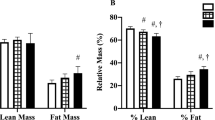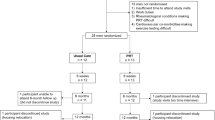Abstract
Introduction
The use of androgen deprivation therapy (ADT) for prostate cancer is on the rise, but its adverse side effects may include increased fat mass and decreased lean muscle mass. The net effect of ADT on BMI is unknown.
Methods
Primary, incident cases of early stage prostate cancer (n = 473) were identified from the Buffalo VA Medical Center tumor registry and matched to body size, demographic, comorbidity, and treatment exposure data from veteran medical records. Multilevel modeling was used to assess the association between ADT and changes in BMI.
Results
On average, survivors were overweight at diagnosis and showed small, non-significant changes in BMI over time. However, among those survivors with a history of ADT, a significant decrease of 0.05 BMI units per year was associated with each additional dose of ADT (p < 0.001). When the association between BMI rate of change and ADT was allowed to vary with respect to age, additional doses of ADT predicted stronger decreases in BMI for younger survivors as compared to older survivors (p < 0.05). Neither a history of surgery nor radiation influenced the association between ADT use and BMI.
Conclusions
Declines in BMI in relation to ADT exposure may be reflective of unfavorable changes in body composition, especially decreased muscle mass, that is most pronounced in younger survivors.
Implications for Cancer Survivors
Survivors on ADT may benefit from close monitoring of physical functioning and referral for exercise interventions to preserve muscle mass and improve health related quality of life.

Similar content being viewed by others
References
Ries LAG, Melbert D, Krapcho M, et al. SEER cancer statistics review, 1975–2004. 2007. Based on November 2006 SEER data submission.
VA National Tumor Registry. Consolidated Data Summary Report. http://vaww1.va.gov/cancer/docs/SUMM2006.doc. Accessed December, 2008.
Wilt TJ, MacDonald R, Rutks I, et al. Systematic review: comparative effectiveness and harms of treatments for clinically localized prostate cancer. Ann Intern Med. 2008;148(6):435–48.
Kawakami J, Cowan JE, Elkin EP, et al. Androgen-deprivation therapy as primary treatment for localized prostate cancer: data from Cancer of the Prostate Strategic Urologic Research Endeavor (CaPSURE). Cancer. 2006;106(8):1708–14.
Lu-Yao GL, Albertsen PC, Moore DF, et al. Survival following primary androgen deprivation therapy among men with localized prostate cancer. JAMA. 2008;300(2):173–81.
Kintzel PE, Chase SL, Schultz LM, et al. Increased risk of metabolic syndrome, diabetes mellitus, and cardiovascular disease in men receiving androgen deprivation therapy for prostate cancer. Pharmacotherapy. 2008;28(12):1511–22.
Mohile SG, Mustian K, Bylow K, et al. Management of complications of androgen deprivation therapy in older men. Crit Rev Oncol/Hematol. 2009;70(3):235–55.
Basaria A, Lieb J, Tang AM, et al. Long-term effects of androgen deprivation therapy in prostate cancer patients. Clin Endocrinol. 2002;56:779–86.
Smith MR, Finkelstein JS, McGovern FJ, et al. Changes in body composition during androgen deprivation therapy for prostate cancer. J Clin Endocrinol Metab. 2002;87(2):599–603.
Potosky AL, Davis WW, Hoffman RM, et al. Five-year outcomes after prostatectomy or radiotherapy for prostate cancer: the prostate cancer outcomes study. J Natl Cancer Inst. 2004;96:1358–67.
Miller DC, Sanda MG, Dunn RL, et al. Long-term outcomes among localized prostate cancer survivors: health-related quality-of-life changes after radical prostatectomy, external radiation, and brachytherapy. J Clin Oncol. 2005;23(12):2772–80.
Sanda MG, Dunn RL, Michalski J, et al. Quality of life and satisfaction with outcome among prostate-cancer survivors. N Engl J Med. 2008;358(12):1250–61.
Stroup SP, Cullen J, Auge BK, et al. Effect of obesity on prostate-specific antigen recurrence after radiation therapy for localized prostate cancer as measured by the 2006 Radiation Therapy Oncology Group-American Society for Therapeutic Radiation and Oncology (RTOG-ASTRO) Phoenix Consensus Definition. Cancer. 2007;110:1003–8.
Wright ME, Chang S-C, Schatzkin A, et al. Prospective study of adiposity and weight change in relation to prostate cancer incidence and mortality. Cancer. 2007;109(4):675–84.
Rodriguez C, Patel AV, Calle EE, et al. Body mass index, height, and prostate cancer mortality in two large cohorts of adult men in the United States. Cancer Epidemiol Biomark Prev. 2001;10:345–53.
Gong Z, Agalliu I, Lin DW, et al. Obesity is associated with increased risks of prostate cancer metastasis and death after initial cancer diagnosis in middle-aged men. Cancer. 2007;109:1192–202.
Peeters AP, Barendregt JJP, Willekens FP, et al. Obesity in adulthood and its consequences for life expectancy: a life-table analysis. Ann Intern Med. 2003;138(1):24–32.
Flegal KM, Graubard BI, Williamson DF, et al. Impact of smoking and preexisting illness on estimates of the fractions of deaths associated with underweight, overweight, and obesity in the US population. Am J Epidemiol. 2007;166(8):975–82.
Fitzpatrick JM. Management of localized prostate cancer in senior adults: the crucial role of comorbidity. BJU Int. 2008;101(Supplement 2):16–22.
Houterman S, Janssen-Heijnen ML, Hendrikx AJ, et al. Impact of comorbidity on treatment and prognosis of prostate cancer patients: a population-based study. Crit Rev Oncol/Hematol. 2006;58(1):60–7.
Fouad MN, Mayo CP, Funkhouser EM, et al. Comorbidity independently predicted death in older prostate cancer patients, more of whom died with than from their disease. J Clin Epidemiol. 2004;57(7):721–9.
Freeman VL, Durazo-Arvizu R, Arozullah AM, et al. Determinants of mortality following a diagnosis of prostate cancer in Veterans Affairs and private sector health care systems. Am J Public Health. 2003;93(10):1706–12.
Das SR, Kinsinger LS, Yancy WS Jr, et al. Obesity prevalence among veterans at Veterans Affairs medical facilities. Am J Prev Med. 2005;28(3):291–4.
Wang A, Kinsinger LS, Kahwati LC, et al. Obesity and weight control practices in 2000 among veterans using VA facilities. Obes Res. 2005;13(8):1405–11.
Nelson KM. The burden of obesity among a national probability sample of veterans. J Gen Intern Med. 2006;21(9):915–9.
NCI. Facing forward: Life after cancer treatment. http://www.cancer.gov/cancertopics/life-after-treatment/page3#b3. Accessed December, 2008.
Davies BJ, Walsh TJ, Ross PL, et al. Effect of BMI on primary treatment of prostate cancer. Urology. 2008;72:406–11.
SAS Institute Inc., SAS 9.2. Cary, NC: 2002–2008.
Hellerstedt BA, Peinta KJ. The current state of hormonal therapy for prostate cancer. CA: a Cancer Journal for Clinicians. 2002;52:154–79.
Katznelson L, Finkelstein JS, Schoenfeld DA, et al. Increase in bone density and lean body mass during testosterone administration in men with acquired hypogonadism. J Clin Endocrinol Metab. 1996;81:4358–65.
Kapoor D, Jones TH. Androgen deficiency as a predictor of metabolic syndrome in aging men: an opportunity for intervention? Drugs Aging. 2008;25:357–69.
Smith MR. Changes in fat and lean body mass during androgen-deprivation therapy for prostate cancer. Urology. 2004;63:742–5.
Berruti A, Dogliotti L, Terrone C, et al. Changes in bone mineral density, lean body mass, and fat content as measured by dual energy X-ray absorptiometry in patients with prostate cancer without apparent bone metastases given androgen deprivation therapy. J Urol. 2002;167:2361–7.
Stoch SA, Parker RA, Chen L, et al. Bone loss in men with prostate cancer treated with gonadotropin-releasing hormone agonists. J Clin Endocrinol Metab. 2001;86:2787–91.
van Londen GJ, Levy ME, Perera S, et al. Body composition changes during androgen deprivation therapy for prostate cancer: a 2-year prospective study. Crit Rev Oncol/Hematol. 2008;68(2):172–7.
Earle CC. Long term care planning for cancer survivors: a health services research agenda. Journal of Cancer Survivorship. 2007;1:64–74.
Levy ME, Perera S, van Londen GJ, et al. Physical function changes in prostate cancer patients on androgen deprivation therapy: a 2-year prospective study. Urology. 2008;71(4):735–9.
Moyad MA. Promoting general health during androgen deprivation therapy (ADT): a rapid 10-step review for your patients. Urologic Oncology: Seminars and Original Investigations. 2006;23:56–64.
Doyle C, Kushi LH, Byers T, et al. Nutrition and physical activity during and after cancer treatment: an American Cancer Society guide for informed choices. CA: a Cancer Journal for Clinicians. 2006;56(6):323–53.
Patterson RE, Neuhouser ML, Hedderson MM, et al. Changes in diet, physical activity, and supplement use among adults diagnosed with cancer. J Am Diet Assoc. 2003;103(3):323–8.
Demark-Wahnefried W, Aziz NM, Rowland JH, et al. Riding the crest of the teachable moment: promoting long-term health after the diagnosis of cancer. J Clin Oncol. 2005;23(24):5814–30.
Jazieh AR, Foraida M, Ghouse M, et al. The impact of cancer diagnosis on the lifestyle and habits of patients served at a Veterans Administration Hospital. J Cancer Educ. 2006;21(3):147–50.
Stevens VJ, Wagner EL, Rossner J, et al. Validity and usefulness of medical chart weights in the long-term evaluation of weight loss programs. Addict Behav. 1988;13:171–5.
DiMaria-Ghalili R. Medical record versus researcher measures of height and weight. Biological Research for Nursing. 2006;8(1):15–23.
Acknowledgments
This work was conducted at and supported by the VA VISN 2 Center for Integrated Healthcare and the VA Western New York Healthcare System, Buffalo, NY.
Author information
Authors and Affiliations
Corresponding author
Rights and permissions
About this article
Cite this article
Beehler, G.P., Wade, M., Kim, B. et al. Longitudinal assessment of BMI in relation to ADT use among early stage prostate cancer survivors. J Cancer Surviv 3, 233–240 (2009). https://doi.org/10.1007/s11764-009-0099-9
Received:
Accepted:
Published:
Issue Date:
DOI: https://doi.org/10.1007/s11764-009-0099-9




